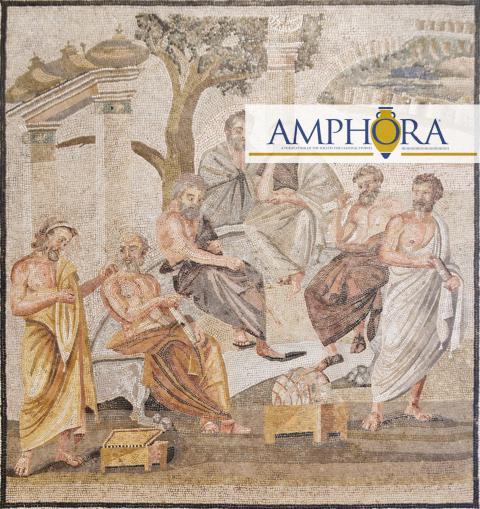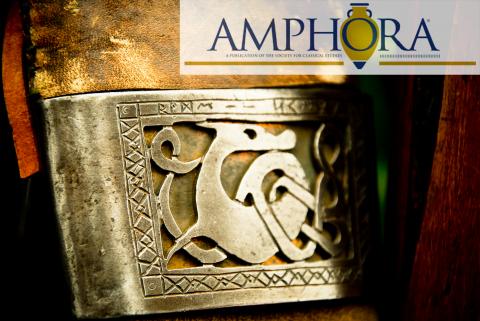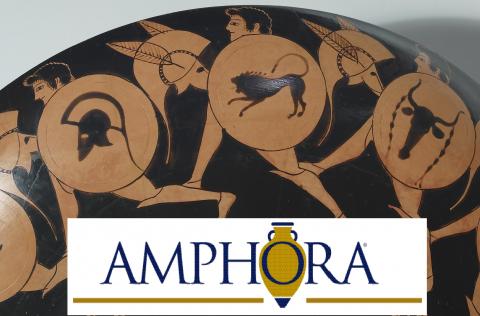SCS Blog Author Page
Posts by Ellen Bauerle

|
Changing the Guard at Amphora
by Dr. Ellen Bauerle After five years seeing the ebb and flow of classical practitioners’ thoughts about outreach, it’s time for me to step down as editor of Amphora. I have very much enjoyed working with the many members of the Amphora editorial board – I’ve made some good new friends, learned about a lot of things going on in the international ferment we call classical studies – and made new discoveries about current pedagogical trends. In the last five years Amphora has moved from an all-print publication format, then to print + website, and now to website-only: I am sure there will be additional developments upcoming as Amphora continues to change and adapt. It’s hard to say goodbye, but I am delighted to announce that Dr. Wells Hansen, who has been my efficient and hard-working assistant editor, is taking over as editor of Amphora, effective with the next issue. Wells and I are together putting the current issue to bed, but as Read more … |

|
Amphora: How to Use the Exhibit Hall at the Annual Meeting
This article was originally published on the Amphora blog on January 6, 2016. If you’re new to academic conferences, or to the joint annual meeting of the SCS/AIA, you may be thinking that the Exhibit Hall is mostly for buying books. And if you’re at the start of your career and/or on a modest budget, you may think that there’s nothing for you in the Exhibit Hall as a result. Au contraire! Here’s a short list of things you can do there—completely aside from buying books—that can be beneficial to your career, fun, interesting, worthwhile, and generally good things to do. The Exhibit Hall is generally open about nine hours a day for the two full days of the conference, plus a half day on either side, so there’s plenty of time to try these in small bits. As a press exhibitor myself (full disclosure) I spend many hours in the hall, so I have a chance to see the variety of exhibitors Read more … |

|
Amphora: Learn to Spend the Big Money: Medievalists Mary Carruthers, Irina Dumitrescu, and Barbara Rosenwein on Humanities Outreach
This article was originally published in Amphora 12.1. It has been edited slightly to adhere to current SCS blog conventions. This spring I was fortunate to hear an interesting panel discussion—stand-up-and-take-notice interesting—at the Medieval Academy of America’s annual meeting, hosted by Notre Dame University. The panelists’ observations seemed to me relevant to the SCS both as demonstrating additional kinds of outreach but more importantly as discussing the peculiar period higher education now finds itself in, and what might be done about that at every level, from junior scholar to dean. Officially the panelists spoke in the context of medieval studies, but they mentioned classical studies at different points, and the vast majority of their comments would be applicable to nearly any department in the humanities, especially those involved with “old stuff” or those commonly regarded by the Read more … |
How to Use the Exhibit Hall at the Annual Meeting
If you’re new to academic conferences, or to the joint annual meeting of the SCS/AIA, you may be thinking that the Exhibit Hall is mostly for buying books. And if you’re at the start of your career and/or on a modest budget, you may think that there’s nothing for you in the Exhibit Hall as a result. Au contraire! Here’s a short list of things you can do there—completely aside from buying books—that can be beneficial to your career, fun, interesting, worthwhile, and generally good things to do. The Exhibit Hall is generally open about nine hours a day for the two full days of the conference, plus a half day on either side, so there’s plenty of time to try these in small bits. As a press exhibitor myself (full disclosure) I spend many hours in the hall, so I have a chance to see the variety of exhibitors who transport their materials or goods or information to the conference, often from international origins, in hopes they’ll have an opportunity to talk with you. One set of Read more … |
|

|
Learn to Spend the Big Money: Medievalists Mary Carruthers, Irina Dumitrescu, and Barbara Rosenwein on Humanities Outreach
by Ellen Bauerle This spring I was fortunate to hear an interesting panel discussion—stand-up-and-take-notice interesting—at the Medieval Academy of America’s annual meeting, hosted by Notre Dame University. The panelists’ observations seemed to me relevant to the SCS both as demonstrating additional kinds of outreach but more importantly as discussing the peculiar period higher education now finds itself in, and what might be done about that at every level, from junior scholar to dean. Officially the panelists spoke in the context of medieval studies, but they mentioned classical studies at different points, and the vast majority of their comments would be applicable to nearly any department in the humanities, especially those involved with “old stuff” or those commonly regarded by the public as recondite. In short, if your discipline has a saying about it on the model of “It’s all [your day job] to me,” you’ll want to listen to the presentations by these three Read more … |
Games and Thrones
by David Potter On May 2, 2015, two men boxed for thirty-six minutes, and each made an enormous amount of money, splitting a record purse of $300 million. Fans may not have seen the greatest fight of all time, or anything close to it, but they did get to boo the winner, Floyd Mayweather, when he strutted around the ring after he was awarded the unanimous decision. The political ambitions of the loser, Manny Pacquiao, do not seem to have been damaged by his defeat. There are already rumors of a rematch. Tiberius Caesar would have been appalled. On May 27, 2015, a series of indictments was issued against leaders of the Fédération Internationale de Football Association (FIFA) for a wide range of corrupt activities in connection with the world’s most widely viewed sporting event, the World Cup. The modern notion that major sports organizations should claim to be self-policing and effectively free of governmental oversight—a privilege also asserted by, for Read more … |
|
Using Low-Cost Hardware for 3D Scanning at Kenchreai, Greece
As the tools and methods for creating 3D models of sites and objects become less expensive, archaeologists are increasingly putting them to good use in the field. This article focuses on my collaborative work to scan objects found at the site of Kenchreai in Greece and now stored nearby in the Isthmia Museum. It does cover practical issues and one goal of writing this piece is to encourage others to explore the creation of 3D content. Accordingly, I stress that 3D tools are becoming easier to use, not just less expensive. And it will be as important to think about what to do with these models after they are made. Permanent access to 3D models is a goal and initial steps towards that are described below. Likewise, rich linking of information about scanned objects to descriptions of their original archaeological findspot will further encourage contextualized studies of Greek and Roman material culture. As 3D content becomes available on the internet, new approaches both to Read more … |
|

|
Amphora: Ancient Narratives and Modern War Stories: Reading Homer with Combat Veterans
For the past seven years, small groups of combat veterans in the Upper Valley of New Hampshire and Vermont have been making Homer their own. This article details the particular value of these small book groups for the veteran, for the community, and for me as the academic facilitator. The proposal for the book groups originated from the premise that literature is able to provide useful insight into life experience and, more specifically, that Homer’s Iliad and Odyssey provide valuable insight—2800 years old—into the problems of soldiers who individually and collectively experienced deep internal conflicts while deployed (Iliad) and who needed somehow to get home (Odyssey). Homer provides a salutary distancing and deflection that, I believe, allows the problems of homecoming to emerge more clearly as a historical problem of the human condition across cultures and political or social organizations: the Read more … |
There Is a Shortage of Certified Latin Teachers: Please Spread the Word!
by Ronnie Ancona and Kathleen Durkin There is a shortage of certified Latin teachers in the United States. Latin teaching positions at the precollegiate level sometimes cannot be filled for lack of qualified applicants. In New York State, for example, where we both teach, in 2012-2013 and 2013-2014, Latin was named specifically as a language with a teacher shortage by the United States Department of Education Office of Postsecondary Education (http://tinyurl.com/mwgdr9j). Not filling a Latin position can result in one of several negative outcomes: the end of a Latin program, the inability to start one, or difficulty with sustaining one. None of these situations is good for maintaining strength in classics at the precollegiate level, where many of our students are first introduced to their excitement about our field. While the shortage does not affect every part of the country equally, it is sufficiently widespread to pose a Read more … |
|
Editing for Good
Elsewhere in this issue, in his article titled The Metal Age, Kris Fletcher discusses the relationship between classical studies and heavy metal music. Examining various metal appropriations of themes, characters, and ideas from classical antiquity, some less orthodox than others, Fletcher notes, “… these songs should remind us that we as classicists do not control this material.” On the SCS website, Mary-Kay Gamel and the Outreach Committee have voiced a similar view concerning the shared understanding of classical material: “We use the word ‘outreach’ not to suggest a one-way communication in which scholars inform others, but a complex interaction in which all involved contribute to a discussion of what Classics is and what it might be.” Not surprisingly, then, in January the Outreach Committee enjoyed a lively discussion of the role of professional classicists and their students as editors of Wikipedia articles on classical subjects. Wikipedia Read more … |
